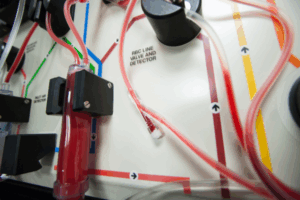Oncology
Mantle Cell Lymphoma
Recognizing Young Patients With Mantle Cell Lymphoma Who May Not Benefit From Intensive Upfront Therapy
Overview
The benefits of intensive first-line regimens in younger patients with mantle cell lymphoma (MCL) and TP53 mutations may be limited. Starting upfront therapy with less intensive options may provide some benefits in this setting by preserving patient functional status and setting the stage for second- and third-line approaches.
Expert Commentary
Brad Kahl, MD
|
|
“In a younger patient with TP53-mutated MCL, you might start with a nonintensive treatment such as bendamustine and rituximab just to get them through a first-line treatment. You could have your BTK inhibitor and chimeric antigen receptor T-cell options lined up and ready to go."
We have learned that an intensive upfront chemotherapy approach in patients with MCL and TP53 mutations, even if they are younger patients, tends to result in unfavorable outcomes. The problem is that we do not know what type of approach is better. This currently represents a major knowledge gap in MCL. We can perhaps extrapolate from our experience with chronic lymphocytic leukemia, where we have learned over the years that conventional chemoimmunotherapy (eg, FCR [fludarabine, cyclophosphamide, and rituximab]) does not produce great results in TP53-mutated disease, whereas treatment with novel oral targeted agents such as the Bruton tyrosine kinase (BTK) inhibitors and venetoclax can produce results in these patients that are much better than chemotherapy-based approaches.
Unfortunately, none of the novel targeted agents are currently approved by the US Food and Drug Administration for use in the frontline MCL setting, so that is a major limitation. In a younger patient with TP53-mutated MCL, you might start with a nonintensive treatment such as bendamustine and rituximab, which is usually fairly well tolerated, just to get them through a first-line treatment. This treatment is not too toxic and may provide 1 or 2 years of remission. At the same time, you can start thinking ahead to second- and third-line options for the patient. I think that the key in this case is to not overtreat your patient in the first-line setting so that they are in good health for the second- and third-line options. You could have your BTK inhibitor and chimeric antigen receptor T-cell options lined up and ready to go.
Multiple trials are testing novel strategies such as BTK inhibitors combined with anti-CD20 monoclonal antibodies in frontline settings. There are some important differences among the BTK inhibitors. Ibrutinib is a fantastic drug for MCL, although the next-generation BTK inhibitors such as acalabrutinib and zanubrutinib seem to have fewer off-target effects and are somewhat better tolerated. Hopefully, there will come a time when some of these novel agents are approved for use in frontline settings, as these would likely be better options for TP53-mutated MCL.
References
Hanel W, Epperla N. Emerging therapies in mantle cell lymphoma. J Hematol Oncol. 2020;13(1):79. doi:10.1186/s13045-020-00914-1
Jain P, Dreyling M, Seymour JF, Wang M. High-risk mantle cell lymphoma: definition, current challenges, and management. J Clin Oncol. 2020;38(36):4302-4316. doi:10.1200/JCO.20.02287
Le Gouill S, Morschhauser F, Chiron D, et al. Ibrutinib, obinutuzumab and venetoclax in relapsed and untreated patients with mantle-cell lymphoma: a phase 1/2 trial. Blood. 2021;137(7):877-887. doi:10.1182/blood.2020008727











